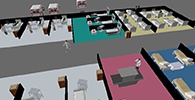Featured in the Society for Health Systems’ March 2015 Newsletter.


What can simulation do for your health system?
Discrete event simulation is a powerful analysis tool that allows users to test different options with real data before a decision is made. While simulation can benefit various industries, this post focuses on the specific advantages of using it in healthcare facilities. Health systems can use simulation to analyze internal data and answer questions about changes to processes, configurations or staffing levels. Without the aid of simulation, facilities often never make these changes because it would be too costly to reorder process steps or test new configurations.
Simulation, when done correctly, can also serve as a real-time decision-making tool. With the advent of electronic medical records and more advanced patient tracking data, there are large amounts of patient data gathered each hour. This data can inform a robust simulation model that can assist in making short-term staffing decisions. Simulation models allow users to adjust variables specific to the system and observe the impact of the changes.

For example, assume a clinician calls in sick. A simulation can project the future volume of an emergency department based on historical and real-time data, and provide helpful information regarding the expected number of staff needed to replace the absent one. This short-term information can lead to significant savings in the long-term.
This post only scratches the surface of the potential uses of simulation. Click the button below to read my next post describing the resources necessary for your successful simulation project!
Simulation in Healthcare: Developing High-Quality Simulations

